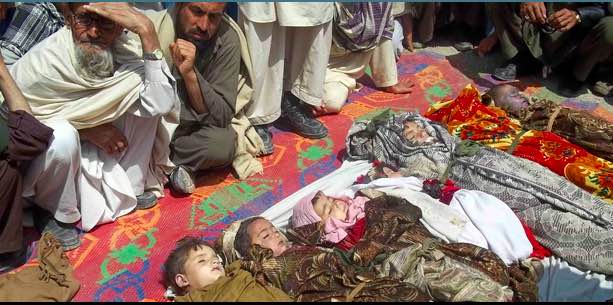
Increase in Civilian Casualties Was Result of Trump Loosening Rules of Engagement
Dave DeCamp / AntiWar.com
(May 7, 2021) — Almost 1,600 children were killed or wounded in airstrikes in Afghanistan over the past five years, according to a report from Action on Armed Violence (AOAV).
The report analyses data released earlier this year by the UN and found that between 2016 and 2020, there were 3,977 civilian casualties from airstrikes in Afghanistan, 1,598 of which were children. Out of that number, 785 were killed, and 813 were wounded.
About 50 percent of the civilian casualties were caused by the US and its NATO coalition partners. The rest were at the hands of the Afghan Air Force, which is entirely propped up by the US.
From 2018 to 2019, the US dropped bombs on Afghanistan at a higher rate than it did during the height of the surge in 2011. In 2019, the US Air Force was responsible for more than two-thirds of child casualties from all airstrikes.
The Trump administration loosened the rules of engagement in Afghanistan, which led to the uptick in airstrikes.
Last year, a report from Brown University’s Costs of War Project found that civilian casualties in airstrikes rose 330 percent from 2016 to 2019 due to the relaxed rules of engagement.
Since the US-Taliban peace deal was signed in February 2020, the US has reduced its airstrikes in the country, although the US has occasionally bombed the Taliban since. In March 2020, US Central Command stopped publishing reports on Afghanistan airstrikes, so there’s no way to know for sure at what rate the US bombed the country that year.
While US bombings decreased in 2020, the Afghan Air Force significantly escalated its airstrikes. The UN found that civilian casualties resulting from airstrikes by the Afghan Air Force during the first six months of 2020 had tripled, compared to the same time period in 2019.
The US is currently withdrawing combat troops from Afghanistan with the goal of getting them out by September 2020. But US financial support for the Afghan military will remain. US military leaders are mulling options on how they will provide maintenance and logistical support after the pullout.

In Last Five Years, 40% of Civilian Casualties from US Airstrikes in Afghanistan — Almost 1,600 — Were Children
Murray Jones / Action on Armed Violence
(May 6, 2021) — Hundreds of children have been killed and hundreds more injured by US and Afghan airstrikes in the past five years, UN data analysed by AOAV can reveal.
Between 2016-2020 (inclusive) there have, in Afghanistan, been:
- 3,977 total civilian casualties from airstrikes: 2,122 civilians killed, 1,855 civilians injured
- 1,598 total child casualties from airstrikes: 785 children killed, 813 children injured
- 40% of all civilian airstrike casualties were children (1,598 of 3,977)
- 37% of those civilians killed by airstrikes were children (785 of 2,122)
- 44% of those civilians injured by airstrikes were children (813 children of 1,855 total)
- The majority (62% — 1,309 of 2,122) of civilian deaths from airstrikes were caused by international forces.
- The majority (50% — 2,000 of 3,977) of overall civilian casualties (deaths and injuries) were also caused by international forces.
- Overall casualties from international airstrikes more than tripled between 2017 and 2019, from 247 to 757.
Explaining the high numbers of child deaths requires context. As foreign ground troop numbers have dwindled in Afghanistan, with a full pull-out expected in September 2021, the NATO operation has become increasingly reliant on US aerial operations, alongside their ally the Afghan Air Force, in their fight against the Taliban. But this form of offensive, especially when used in populated areas, has had devastating impacts on Afghan civilians in the past five years, as an analysis of data from the United Nations Assistance Mission in Afghanistan (UNAMA) reveals.
The road to almost 1,600 children being killed or injured by airstrikes in Afghanistan was paved, in part, in late 2017, when then-Secretary of Defense Jim Mattis announced that the Rules of Engagement for airstrikes against the Taliban had been loosened, enabling the US Air Force to conduct more airstrikes. This was part of President Trump’s promise to “lift restrictions and expand authorities” for fighters in Afghanistan.
In each of the following two years, the US dropped more weapons on Afghanistan than in the height of their presence in 2011 — at a rate of more than 20 a day.

Such heavy bombardment resulted in the deadliest year of airstrikes for children in Afghanistan on record, AOAV can reveal. In 2018, 236 minors were killed by airstrikes. Another 256 were injured, leaving a total of 492 child casualties This was an 85% increase on the year before, resulting in a rate of four child casualties every three days.
The majority (57%) of these child casualties were caused by US-led international forces.
Combining adult civilian and child victims, international forces were responsible for the majority (64%, or 644) of the 1,013 civilian casualties from airstrikes in 2018.
For Afghan civilians, this was more than double (2.6 times) the international airstrike casualty rate of the year before (2017). UNAMA cited particular concerns of international strikes on structures and in support of Afghan ground operations in 2018. But their warnings went unheeded, by the end of 2019 the annual casualty rate from US strikes was triple that of 2017.
In 2019, the US Air Force were responsible for more than two-thirds (69%) of child casualties from airstrikes. 2018 and 2019 were a reversal from 2016 & 2017 when the Afghan Air Force were responsible for more overall civilian casualties than the US.
This switch was fuelled by the relaxed rules of engagement from the US, announced in October 2017. The new regulations allowed the US to strike at Taliban targets even if they were not in proximity to any NATO or Afghan forces and it would allow more US operatives to be embedded with Afghan forces, permitting them to authorise more airstrikes.

One such incident ended tragically.
On the morning of 19 July 2018, the US Air Force carried out airstrikes on a residential compound in Chahar Dara district, Kunduz province, resulting in the death of 14 women and children, all from the same extended family. The strike took place during an Afghan National Army ground operation. During the fighting, a member of the family asked for help from the local police, but before anything could be done the US fired a missile onto the street corner. A second bomb was then dropped directly on the house, completely destroying the building and killing everyone inside, apart from one baby.
Both the Afghan and American militaries at first denied any civilian casualties. Soon the Afghan Ministry of Defence admitted wrongdoing and paid compensation. The US forces eventually launched an investigation on 25 July. By August 10, they released a statement, continuing to deny any civilian victims. It took significant protest from the United Nations Assistance Mission in Afghanistan (UNAMA) for the US to launch another formal investigation, eventually admitting 12 civilians were killed and one injured.
But this kind of wrangling over civilian deaths is commonplace.
In both 2018 and 2019, UNAMA and the US diverge dramatically on the figures. In 2018, the US only acknowledged 117 civilian casualties from airstrikes (70 killed, 47 injured). A difference of over 500%. Again, in 2019 the US counts 97 deaths and 59 injuries due to their airstrikes. A margin of nearly 500%.
In March 2020, soon after an initial deal had been signed with the Taliban to end the war, the US scaled back its aerial operations. At the same time, the US Air Forces Central Command (AFCENT) ceased to publish monthly aerial operations data in Afghanistan, something they’d done since 2012 so there is no publicly available data from the US military from March 2020 onwards.
However, in the first two months of 2020, UNAMA attributed 39 child casualties (32 killed and 7 injured) to airstrikes from international military forces — that’s more than one child casualty every two days by the US.
Despite the deadliness of the US Air Force’s operations in the past five years, there is still concern about the future threat that the Afghan Air Force poses to civilians as they take control of aerial operations. UNAMA found that civilian casualties resulting from airstrikes by the Afghan Air Force during the first six months of 2020 had tripled, compared to the same time period in 2019.
Even as the US military pulls out of Afghanistan this year, their leaders cannot distance themselves from this harm. They helped establish the Afghan Air Force in its current form, and have supplied and trained it since 2005, spending $8 billion over the past decade in the process.
The Taliban has continued to attack Afghan forces and civilians during the peace talks process that began in Doha in September 2020. And many fear that the US withdrawal, along with other international forces including the UK, will lead to further destabilisation and violence.
Colonel Simon Diggins, former British defence attaché in Kabul, told The Times, the US and Britain were giving a “green light to the Taliban to take over”.
This was backed up by an Annual Threat Assessment report from the US Director of National Security that read: “We assess that prospects for a peace deal will remain low during the next year. The Taliban is likely to make gains on the battlefield, and the Afghan Government will struggle to hold the Taliban at bay if the coalition withdraws support.”
President Biden has overruled such warnings and committed to a US withdrawal by September 11, 2021 — the 20-year anniversary of the 9/11 attacks. Although it is likely that several hundred Special Forces and private military contractors will remain in Afghanistan. The Taliban themselves have focused on the fact that this announcement means the US have missed the May 1 deadline agreed under the Trump administration.
Zabihullah Mujahid, a Taliban spokesman, said on local television. “Any delay after May 1 is not acceptable for us.”
With the U.S-trained Afghan Air Force now set to take the lead on airstrikes, desperately fighting against a resurgent Taliban, it’s clear the risk to civilians from aerial weapons remains and may worsen.
Additional reporting: Eliza Ader and Ana Marija Apostoloska
Posted in accordance with Title 17, Section 107, US Code, for noncommercial, educational purposes.